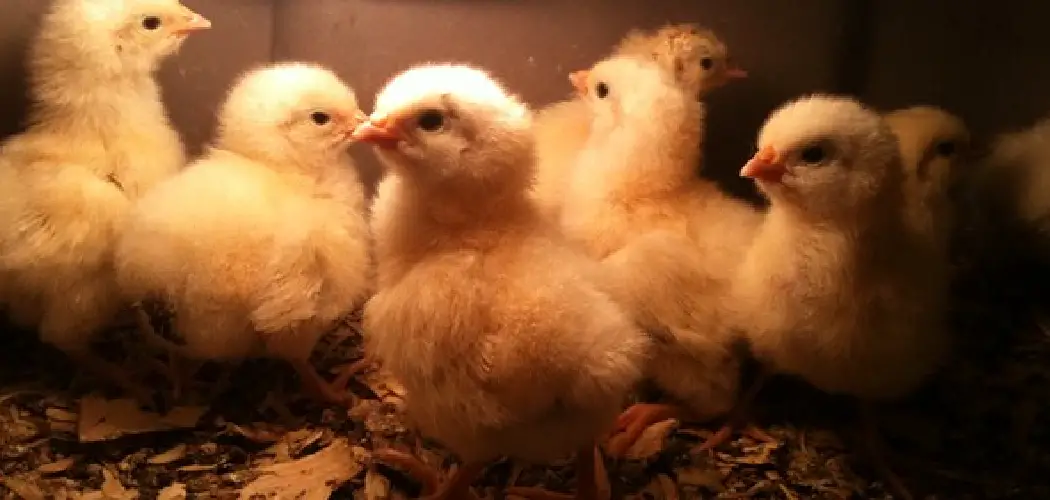There are several reasons why you should be concerned about the temperature of your chicks. As a poultry farmer, it is important to ensure that the environment for your chicks is just right. This will not only promote their growth and health, but it will also prevent any potential losses due to overheating or cold.
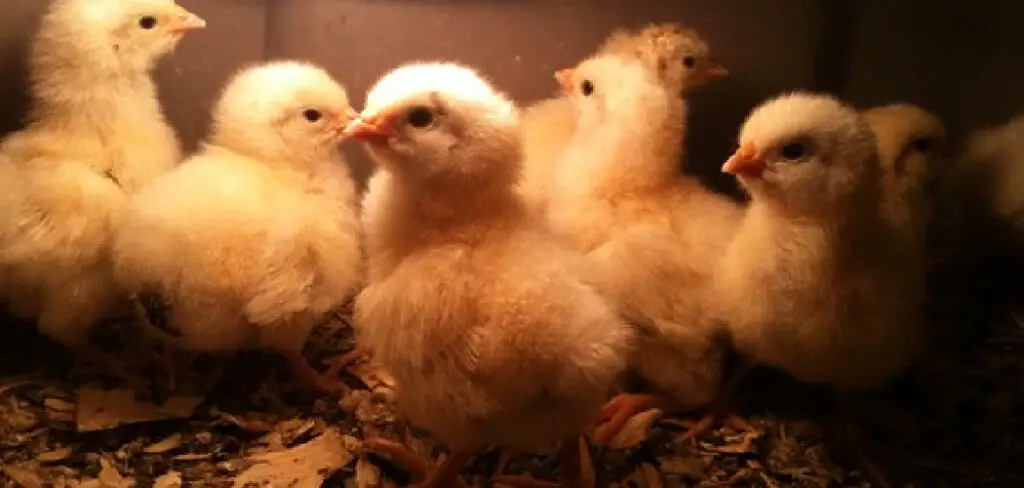
The main advantage of knowing to tell if chicks are too hot is that it can help prevent heat stress and death in young chicks. Heat stress is a common issue faced by poultry farmers, especially during the summer months when temperatures are high. By being able to accurately identify signs of heat stress in chicks, farmers can take quick action to cool them down and prevent any potential health problems. In this blog post, You will learn in detail how to tell if chicks are too hot.
Step-by-step Instructions for How to Tell if Chicks Are Too Hot
Step 1: Inspect the Temperature of the Brooder
The first step in determining if chicks are too hot is to inspect the temperature of their brooder. A brooder is an enclosed area where young chicks are kept warm and safe. The ideal temperature for newly hatched chicks is between 95-100°F (35-37°C). Use a thermometer to check the temperature inside the brooder.
Step 2: Observe the Behavior of the Chicks
The behavior of chicks can tell you a lot about their comfort level. If they are constantly huddled together in one corner, panting with wings spread out, or avoiding areas with heat sources, it could be a sign that they are too hot.
Aside from behavior, there are physical signs that indicate your chicks may be too hot. These include pale or red combs and wattles (the fleshy areas on top of their heads), droopy wings, and open-mouthed breathing.
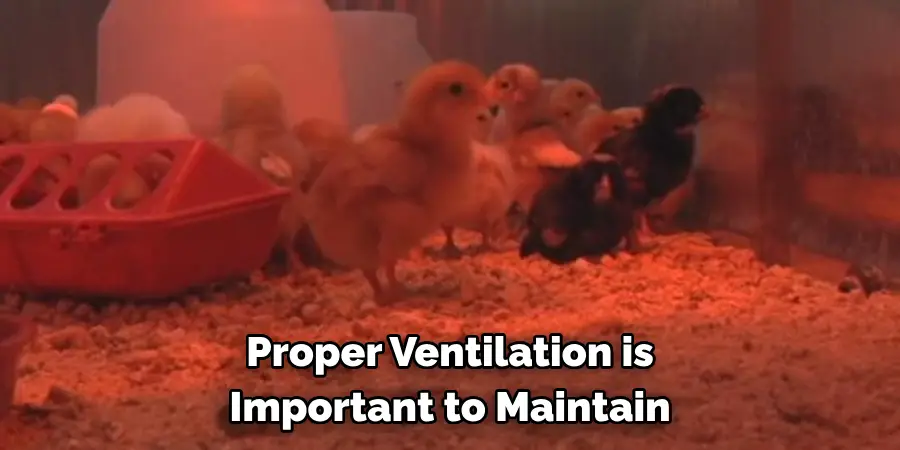
Step 3: Monitor the Brooder Temperature
To ensure that the brooder temperature stays within the appropriate range, it is important to regularly monitor it throughout the day. Use a thermometer designed for brooders or one specifically made for measuring animal body temperatures.
If your thermometer readings indicate that the brooder is too hot, you can adjust the heat source to reduce the temperature. This could mean raising the heat lamp higher, lowering its wattage, or using a heat plate instead.
Step 4: Provide Adequate Ventilation
Proper ventilation is important to maintain a comfortable and healthy environment for chicks. Without enough air circulation, the brooder can quickly become too hot and stuffy. Use a fan or open windows to allow fresh air to flow through the space. Chicks need access to clean, cool water at all times to regulate their body temperature. If they are too hot, they will drink more water than usual and may even take a dip in the water dish for relief.
Step 5: Create Cool Spots
To give your chicks a break from the heat, you can create cool spots within the brooder. This could be as simple as placing a shallow dish of water in one corner or providing a shady area for them to rest in. High humidity levels can also contribute to chicks feeling too hot. Use a hygrometer to monitor the humidity inside the brooder and make adjustments as needed, such as using a dehumidifier or adding more ventilation.
Step 6: Seek Veterinary Help if Necessary
If your chicks are showing severe signs of overheating such as lethargy, labored breathing, or panting excessively, it is important to seek veterinary help immediately. These could be signs of heatstroke and can be life-threatening if not treated promptly.
By following these step-by-step instructions, you can ensure the health and comfort of your chicks by keeping them at the right temperature. Remember to regularly monitor their behavior and environment, and make adjustments as needed to provide a safe and comfortable space for your young feathered friends.

Safety Precautions for How to Tell if Chicks Are Too Hot
- Avoid overcrowding the chicks in the brooder. Make sure to provide enough space for them to move around freely.
- Keep an eye on the temperature of the brooder. Use a thermometer to monitor and maintain appropriate temperature levels.
- Place a heat source at one end of the brooder, so that chicks can thermoregulate by moving closer or further away from it.
- Provide clean and fresh water at all times, especially during hot weather. Dehydration can occur quickly in chicks.
- Consider using a brooder guard to prevent drafts, which can cause chilling and stress to the chicks.
- Avoid handling the chicks too often. Frequent handling can cause unnecessary stress and can also disrupt their ability to regulate body temperature.
- Make sure there is proper ventilation in the brooder to prevent build-up of heat and ammonia from droppings.
By following these safety precautions, you can ensure that your chicks are comfortable and healthy in their brooder. Remember to always prioritize the well-being of your chicks and make adjustments as necessary to keep them safe from overheating.

What Are the Signs of Heat Stress in Chicks?
Heat stress in chicks can have serious consequences and it is important for poultry farmers to be able to recognize the signs. Some of the key indicators of heat stress in chicks may include:
- Panting – Chicks do not sweat like humans, so panting is their main way of trying to cool down. If you notice your chicks panting excessively, it could be a sign of heat stress.
- Holding Their Wings Away From Their Body – Chicks will often try to cool down by holding their wings slightly away from their body, creating more surface area for air to circulate.
- Lethargy and Weakness – Heat-stressed chicks may appear weak or lethargic, as the high temperatures can cause them to become fatigued and less active.
- Decreased Feed Intake – Heat-stressed chicks may also have a decreased appetite, which can lead to weight loss and slower growth.
- Reduced Water Consumption – Along with decreased feed intake, heat-stressed chicks may also drink less water, which can contribute to dehydration and further health issues.
- Huddling Together – Chicks will often huddle together in an attempt to share body heat and cool down, so if you notice your chicks in a tight group, it could be a sign of heat stress.
- Pale Combs and Wattles – The combs and wattles of chickens can become pale or discolored when they are suffering from heat stress.
- Diarrhea – Extreme heat can also cause chicks to experience diarrhea, which can be a sign of dehydration and other health problems.
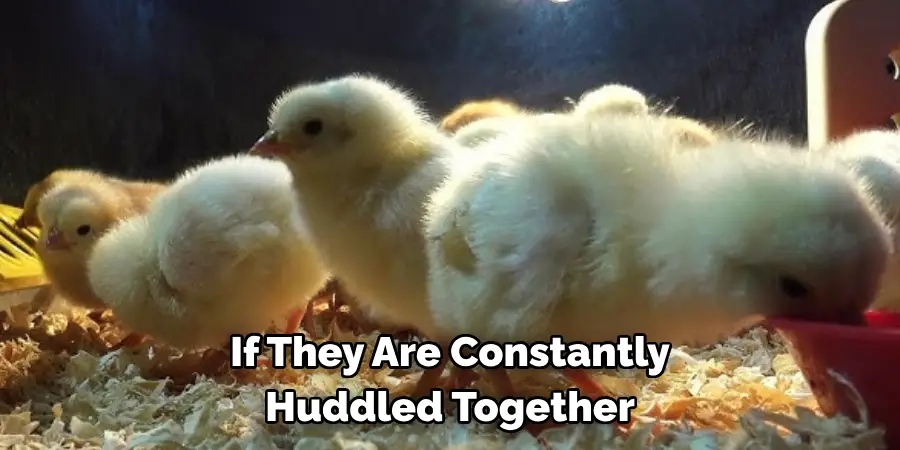
If you notice any of these signs in your chicks, it is important to take immediate action to prevent further heat stress. This may include providing cool water for the chicks to drink, increasing ventilation in their living space, or moving them to a cooler location if possible.
What Are the Potential Dangers of Chicks Being Too Hot?
Chicks are delicate creatures that require special attention and care, especially during their early stages of life. One of the most important factors in raising healthy chicks is providing them with optimal temperature conditions. However, too much heat can be dangerous for these young birds and can even result in death if not addressed promptly. Here are some potential dangers of chicks being too hot:
1. Dehydration
High temperatures can quickly lead to dehydration in chicks. As their bodies try to regulate their internal temperature, they lose moisture through evaporation and end up dehydrated. This can be fatal for the chicks, especially if left untreated.
To prevent dehydration, make sure your brooder is well-ventilated and has a constant supply of fresh water. You can also add electrolytes to their water to help replenish any lost fluids.
2. Overheating
Chicks cannot sweat, making it difficult for them to cool down when they are too hot. This can lead to overheating, which can cause heat exhaustion and even heat stroke. Signs of overheating include panting, lethargy, and spreading their wings away from their body.
To prevent overheating, make sure the temperature in their brooder is not too high and that they have access to cool areas. You can also place a shallow dish of water in their brooder for them to stand in and cool down.
3. Respiratory Issues
Chicks are susceptible to respiratory issues, and excessive heat can worsen these conditions. When the air is too hot and dry, it can cause the chicks’ respiratory tract to become irritated and inflamed. This can lead to difficulty breathing and even respiratory infections.
To prevent respiratory issues, make sure your brooder is well-ventilated and not too hot. You can also add a humidifier or spray water into the air to increase moisture levels.
4. Stunted Growth
Excessive heat can also hinder the growth and development of chicks. When their bodies are focused on regulating their temperature, they may not have enough energy to grow and develop properly. This can result in stunted growth and weaker birds.
To ensure proper growth, maintain a consistent and optimal temperature in the brooder and provide a balanced diet for your chicks.
5. Behavioral Issues
Chicks that are too hot may also exhibit behavioral issues such as lethargy, lack of appetite, and excessive drooling. They may also become aggressive towards other chicks or themselves due to the discomfort they are experiencing.
To prevent behavioral issues, constantly monitor the temperature in their brooder and make sure it is not too high. You can also provide them with toys or distractions to keep them active and entertained.
As a responsible chicken owner, it is important to constantly monitor the temperature in their brooder and take necessary precautions to ensure their safety and health. By understanding the potential dangers of chicks being too hot, you can provide them with the proper care and environment they need to thrive.
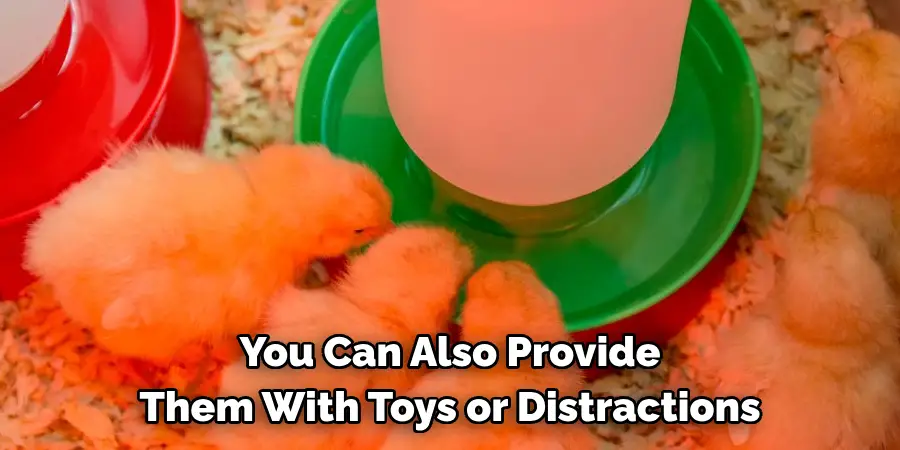
Are There Any Alternative Methods to Regulate Chick’s Temperature Besides Using a Brooder Lamp?
Yes, there are alternative methods to regulate a chick’s temperature besides using a brooder lamp. Here are some options you can consider:
1. Heat Plates
Heat plates, also known as electric heating pads, provide a more natural heat source for chicks compared to traditional brooder lamps. They mimic the warmth they would naturally receive from their mother hen and allow them to regulate their own body temperature. Heat plates also pose a lower risk of fire compared to brooder lamps.
2. Ceramic Heat Emitters
Ceramic heat emitters are another alternative to brooder lamps. They emit infrared heat, which is safe and effective in keeping chicks warm without the use of light. These heat emitters can also be placed outside of the brooder, allowing the chicks to move away from the heat source if they become too hot.
3. Mother Hen Cloak
If you have a broody hen, you can also use a mother hen cloak to regulate your chick’s temperature. This is essentially a small blanket or cloth that is placed over the chicks and mimics the warmth and shelter of a mother hen. This method may not be suitable for all chicks, as some may become too hot or aggressive under the cloak.
4. Natural Heat Sources
Depending on your climate and location, you may also be able to use natural heat sources to regulate a chick’s temperature. These can include using natural sunlight or heat from a nearby fire source. It is important to constantly monitor the temperature with these methods and make adjustments as needed to ensure the chicks are not too hot or cold.
Overall, there are various alternative methods to a brooder lamp that can help regulate a chick’s temperature. It is important to consider your specific situation and assess which method would work best for you and your chicks.
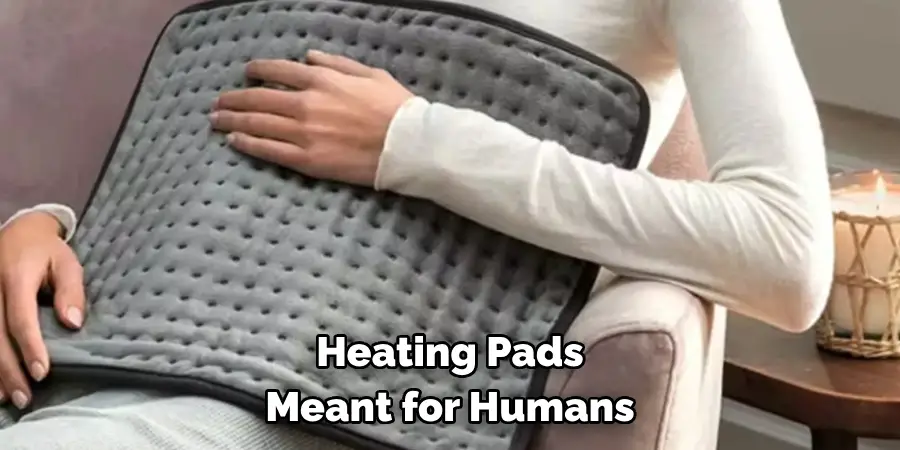
What Are Some Common Mistakes People Make When Trying to Keep Chicks Warm?
Here are some common mistakes people make when trying to keep chicks warm:
1. Using a brooder lamp without a thermostat
A common mistake is relying solely on the wattage of the bulb in a brooder lamp to regulate temperature without using a thermostat. This can lead to inconsistent and potentially dangerous temperature fluctuations for the chicks.
2. Not providing enough ventilation
While it is important to keep chicks warm, it is equally important to provide them with proper ventilation. Without adequate air flow, the brooder can become too hot and stuffy, leading to respiratory issues.
3. Not monitoring temperature regularly
It is crucial to constantly monitor the temperature in the brooder and make adjustments as needed. Many people make the mistake of assuming that once they set up the brooder lamp, it will maintain a constant temperature. However, external factors such as room temperature and weather can affect the brooder’s temperature.
4. Using heat sources that are too strong
Some people may use heat sources that are too strong for their chicks, such as space heaters or heating pads meant for humans. This can lead to overheating and potential harm to the chicks.
By avoiding these common mistakes and being attentive to your chicks’ temperature needs, you can provide them with a safe and comfortable environment for healthy growth and development. Overall, it is important to constantly educate yourself on proper chick care and seek guidance from experienced chicken owners or veterinarians if needed.

Are There Any Warning Signs That Indicate the Brooder Lamp is Not Working Properly?
There are several warning signs that may indicate that the brooder lamp is not working properly. These include:
- Flickering or Dim Light: If the light emitted by the brooder lamp is flickering or becomes dimmer than usual, it could be a sign of a faulty bulb or a loose connection.
- Uneven Heat Distribution: The purpose of the brooder lamp is to provide a constant source of heat for the young chicks. If you notice that some areas under the bulb are warmer than others, it could indicate that the lamp is not working properly.
- Burn Marks or Discoloration: Check the area around the brooder lamp for any signs of burn marks or discoloration. This could mean that the lamp is producing too much heat and could potentially cause a fire.
- Overheating: If the chicks are constantly huddling together or panting excessively, it could be a sign that the brooder lamp is giving off too much heat. This could be dangerous for the chicks and may lead to dehydration or even death.
- Strange Noises: A properly functioning brooder lamp should be relatively silent. If you hear any strange noises coming from the lamp, it could indicate that there is something wrong with the internal components.
If you notice any of these warning signs, it is important to address the issue immediately for the safety and well-being of your chicks. It is recommended to regularly check and inspect your brooder lamp for any potential issues before placing the chicks under its heat source.
Conclusion
In conclusion, while raising chicks can be an exciting and rewarding experience, it’s important to understand the signs of overheating in order to ensure their health and well-being. By monitoring their body language, behavior, and environment, you can easily determine if your chicks are too hot and take necessary measures to cool them down.
However, constantly checking on the temperature and preventing overheating is not a simple task. It requires dedication, attention to detail, and proper knowledge of the signs of overheating. I hope this article has been beneficial for learning how to tell if chicks are too hot. Make Sure the precautionary measures are followed chronologically.
About
Outdoor Fixes is a distinguished figure in the world of Diy design, with a decade of expertise creating innovative and sustainable Diy solutions.
His professional focus lies in merging traditional craftsmanship with modern manufacturing techniques,
fostering designs that are both practical and environmentally conscious. As the author of diy,
outdoorfixes delves into the art and science of outdoorfixes-making, inspiring artisans and industry professionals alike.
Education RMIT University
(Melbourne, Australia) Associate Degree in Design (Outdoor Fixes) Focus on sustainable design, industry-driven projects,
and practical craftsmanship. Gained hands-on experience with traditional and digital manufacturing tools, such as CAD and CNC software.
Nottingham Trent University
(United Kingdom) Bachelor’s in outdoorfixes.com and Product Design (Honors) Specialized in product design with a focus on blending creativity with production
techniques. Participated in industry projects, working with companies like John Lewis and Vitsoe to gain real-world insights.
Publications and Impact
In diy, Outdoor Fixes his insights on indoor design processes, materials, and strategies for efficient production.
His writing bridges the gap between artisan knowledge and modern industry needs, making it a must-read for both budding designers and seasoned professionals.

